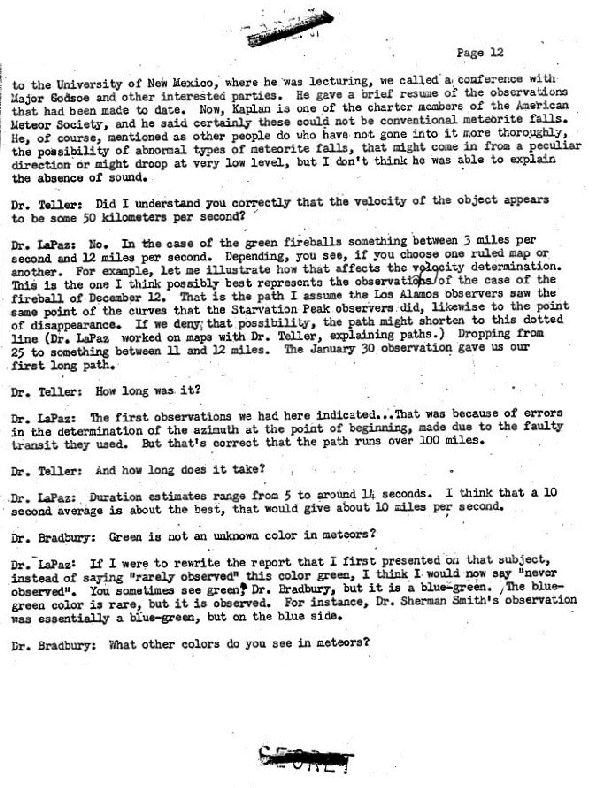This is one of the 24 pages of one of the many formerly secret official documents on this issue. These pages are the minutes of an important conference on the issue held at Los Alamos on February 16, 1949. Representatives of the Army, the FBI, the Air Force and scientists joined together. Dr. La Paz spent two years chasing the green fireballs and explains the issues. Dr. Edward Teller, one of the fathers of the atomic bomb, asks questions.
1 2 3 4 5 6 7 8 9 10 11 12 13 14 15 16 17 18 19 20 21 22 23 24

|
to the University of New Mexico, where he was lecturing, we called a conference with Major Godsoe and other interested parties. He gave a brief resume of the observations that had been made to date. Now, Kaplan is one of the charter member of the American Meteor Society, and he said certainly these could not have been conventional meteor falls. He, of course, mentioned as other people do who have not gone into it more thoroughly, the possibility of abnormal types of meteor falls, that might come from a peculiar direction or might droop at very low level, but I don't think he was able to explain the absence of sound.
Dr. Teller: Did I understand you correctly that the velocity of the objects appears to be some 50 kilometers per second?
Dr. LaPaz: No. In the case of the green fireballs something between 3 miles per second and 12 miles per second. Depending, you see, if you choose one ruled map or another. For example, let me illustrate how that affects the velocity determination. This is the one I think possibly best represents the observation of the case of the fireball of December 12. That is the path I assume the Los Alamos observers saw the same point of the curves that the Starvation Peak observers did, likewise to the point of disappearance. If we deny that possibility, the path might shorten to this dotted line (Dr. LaPaz worked on maps with Dr. Teller, explaining paths.) Dropping from 25 to something between 11 and 12 miles. The January 30 observation gave us our first long path.
Dr. Teller: How long was it?
Dr. LaPaz: The first observation we had indicated ... That was because of errors in the determination of the azimuth at the point of beginning, made due to the faulty transit they used. But that's correct that the path runs over 100 miles.
Dr. Teller: And how long does it take?
Dr. LaPaz: Duration estimates range from 5 to around 14 seconds. I think that a 10 second average is about the best, that would give about 10 miles per second.
Dr. Bradbury: Green is not an unknown color in meteors?
Dr. LaPaz: If I were to rewrite the report that I first presented on that subject, instead of "rarely observed" this color green, I think I would now say "never observed." You sometimes see green, Dr. Bradbury, but it is a blue green. The blue-green color is rare, but it is observed. For example, Dr. Sherman Smith's observation was essentially a blue-green, but on the blue side.
Dr. Bradbury: What other colors do you see in meteors?
1 2 3 4 4 6 7 8 9 10 11 12 13 14 15 16 17 18 19 20 21 22 23 24